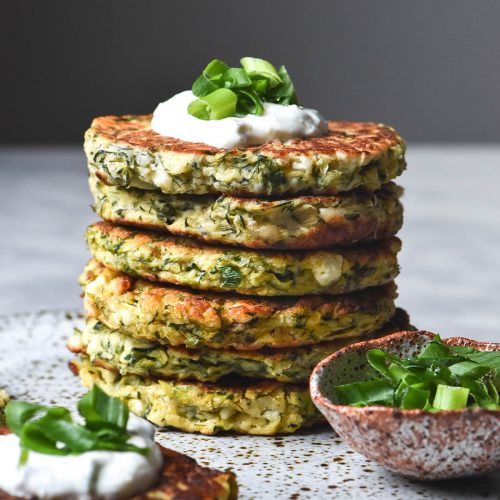
Gluten free zucchini fritters
Teaspoons are in Australian measures. Teaspoons in Canada, New Zealand and Australia are 5ml. In the USA, they are 4.9ml. In Britain, they are 5.9ml.
Ingredients
- 1 kg zucchini
- 2 teaspoons salt
- 30-50 g dill or mint very finely chopped
- 1/2 bunch spring onion greens very finely chopped
- 1-4 - 1/2 teaspoon salt (see notes)
- Freshly cracked pepper to your taste
- 50-75 g almond meal see notes
- 50-75 g cassava flour or buckwheat flour see notes
- Zest of 1 lemon
- 200 g firm feta crumbled into small pieces
- 1/2 teaspoon baking powder (optional, see notes)
- 2-3 extra large eggs
- Vegetable oil or neutral oil for cooking
Instructions
- Grate the zucchini on the large side of your box grater and place into a colander over the sink. Sprinkle over the 2 teaspoons of salt and massage it in with your hands. Begin to wring the zucchini of excess of moisture. I like to leave mine for 10 minutes in between wringing it out to allow it to drain off.
- Place the partially wrung out zucchini in a clean, dry thin tea towel or muslin cloth (a nut milk bag is too delicate here).
- Go to town on wringing out the zucchini – you want to remove as much liquid as humanly possible. I aim for the zucchini to weigh between 350-500g once fully wrung out. The less liquid there is, the easier forming your fritters will be.
- Once your zucchini is shrivelled and dry, break it up into a large bowl. Add all the ingredients except the eggs and taste for seasoning. If you’re adding any extra flavourings like chilli, add them here.
- When you’re happy with the taste, add the eggs. If the mixture is moist and easily forms patties with two eggs, only add two. If it’s still a little dry and crumbly, add three.
- Thoroughly preheat a pan over a medium high heat. I preheat mine without oil for 3-5 minutes to ensure it is exceptionally well heated so the fritters don’t stick.
- Turn the heat to low medium. Take about 1/8th of the mixture and form a patty in your hands. Flatten it out to about 1-2cm thick, then place it on the pan. Use a spatula to flatten it out a little. Thick fritters are more likely to be undercooked inside, so you want them to be reasonably thin. After about 2 minutes (heat dependent) flip the fritter. Each fritter needs about 5-7 minutes to cook through, heat and size dependent. You can cook multiple fritters at a time with a decent sized pan.
- Once each fritter is cooked, place it on a cake ran so it doesn’t sweat underneath. Repeat with the remaining fritters, then serve. If you’d like to freeze the fritters, allow them to cool completely then pack into airtight containers.
Notes
- I have written extensive tips for successful fritters in the body of the post - too many to re-write here. Have a read of those for the best fritters.
- You can use all buckwheat flour or 50-75g almond meal and 50-75g buckwheat flour in place of the flours listed in the recipe. I found all cassava flour to be a bit gluey hot, but better cold.
- Add salt according to how salty your feta is and your taste for salt.
- Another option is to add 1/2 teaspoon baking powder just to aerate the fritters inside a little bit. You don't have to add it, but it does add a little somethin'.
- I haven't tested these fritters without the eggs or cheese. I also haven't tested them with a dairy free cheese.
Tried this recipe?Let us know how it was!